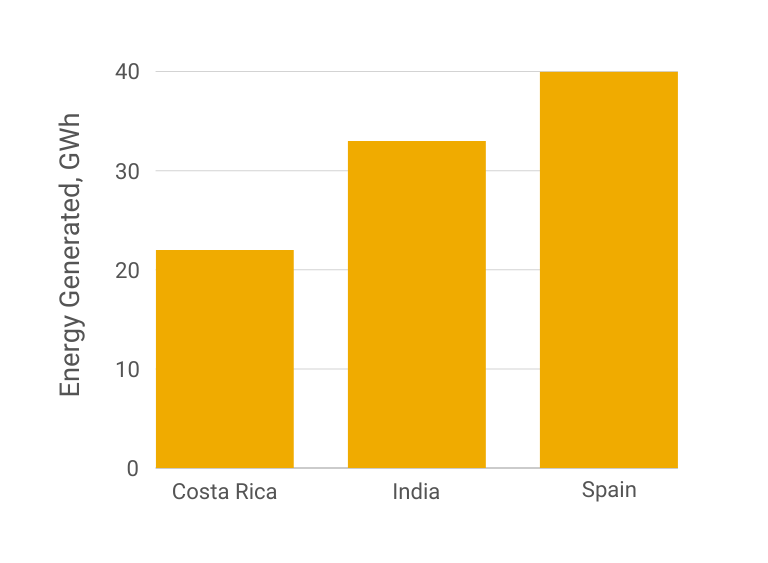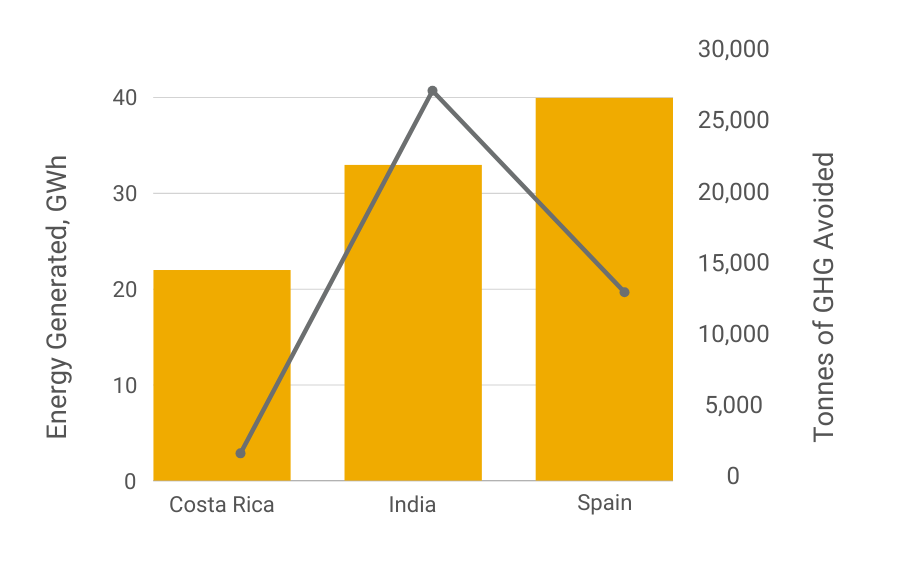Investors with sustainability goals often face a seemingly binary choice between investments with or without a positive impact – for example, choosing between green bonds versus vanilla bonds. Whether projects have a positive social or environmental impact is often treated like a “yes” or “no” question, with the answer based on meeting a certain threshold or criteria within a taxonomy. In this article, we will look at examples of how investors can take a more quantified approach when considering sustainable bonds, to potentially maximize the impact of their investments.
Considerations for Optimizing Impact
Whether a project is considered green typically depends on the technology or activity that is being invested in (e.g., wind, solar, etc.), rather than the environmental outcomes associated with the project. Such projects are often given the “green” label, however, the actual impact that these projects have can vary widely based on their context.
Let’s take for example, electricity generation. Under what circumstances would an electricity generation project make the biggest difference? The examples that follow illustrate the factors investors might consider to optimize the impact of their investment.
Geographic Context and Renewable Energy Costs
When looking at electricity generation projects, one consideration is the amount of generation capacity that can be purchased. Depending on local economic and regulatory circumstances, the cost of renewable energy generation capacity varies significantly. This includes the lifetime cost to generate energy for the utility or company, including the construction and maintenance of the power plant.
With that in mind, we will use wind energy as an example, and look at how much wind energy generation capacity US$1 million could buy1 in three countries chosen as illustrative examples.
Figure 1. Amount of Onshore Wind Power Generation Capacity Purchased for US$1 Million

Source: International Renewable Energy Agency, October 2023
The amount of power that can be purchased for US$1 million varies from 22 gigawatt hours (GWh) in Costa Rica to 40 GWh in Spain (which is roughly the amount of electricity to run a small town for one day). This is the initial measure of how much bang we are getting for our buck.
The Greenhouse Gas Avoidance of Renewable Energy
Yet the amount of energy generated for a given dollar amount is not what determines impact. In the case of electricity generation, we can also use a key performance indicator, such as greenhouse gas (GHG) avoidance.
The amount of carbon emissions avoided from a renewable energy project is determined by the type of energy that the new renewable energy is replacing, also known as the baseline. For example, when new wind power plants are used, they create zero emissions. This clean energy replaces some of the energy currently being generated from fossil fuels, resulting in avoided emissions. The cost and GHG avoidance of this new energy investment is what is used to calculate the cost efficiency, and this differs depending on the country.
In most cases, the energy being displaced by renewable energy is from the national electricity grid. The amount and type of emissions created can differ greatly depending on the energy mix or sources of energy that the grid draws from within the country. Costa Rica has an electricity grid that is among the cleanest in the world because almost all the energy generated in the country is from renewable sources. Costa Rica has an emission rate of 39 g/kWh compared to coal-dependent India with an emission rate of 608 g/kWh.2 In Figure 2, we compare the same three example countries, with the grey line depicting how many tonnes of GHG are avoided.
Figure 2. Amount of Wind Power Generation Capacity Purchased for US$1 Million Compared to the Amount of GHG Avoided per Country

Source: International Renewable Energy Agency, October 2023 and UNFCCC, “Harmonized IFI Default Grid Factors 2021 v3.2,” October 2023
Wind power is relatively more expensive in Costa Rica, as US$1 million buys 22 GWh (Figure 1). But because Costa Rica’s existing grid is already so clean, the new energy being generated by wind power is mainly displacing other types of renewable energy, with only a small share of fossil fuel energy being displaced. This local context makes the GHG avoidance from a renewable energy project built in Costa Rica the lowest among the three countries (see Figure 2), with US$1 million buying 1,800 tonnes of avoided GHG, or 1.8 kg per dollar.3
In India, the cost of energy is lower, so we can buy 33 GWh worth of generation capacity with US$1 million, but because the current grid is so carbon intensive, the GHG avoidance is the highest of the group, at 27,000 tonnes of GHG, or 27 kg per dollar.4 Finally, in Spain, the energy cost was the lowest, so we get the most energy generated at 40 GWh, and avoid 13,000 tonnes of GHG, or 13 kg per dollar.5
If the investment choice is onshore wind in these three countries, Spain is where you will generate the most renewable energy, but it’s in India where the climate impact would be the highest.
Other Considerations: Non-Climate Impacts
An important note is that these examples only measure GHG avoided and do not consider non-carbon-related side effects of the investment such as jobs, pollution, or biodiversity. To properly consider these effects, they would have to be measured against each other in a way that is not yet commonly done in the market. For simplicity, the primary focus of the examples above is climate. Secondary outcomes like pollution reduction are also highly correlated with climate impact.
The Importance of Incorporating Context Into Impact Metrics
The examples above show that in measuring the impact of sustainable investments, context is often lacking in the metrics calculation themselves. When it is considered, it is typically viewed as qualitative information and not quantified into impact metrics. Generally, investing in a technology or project classified as green is considered enough by investors, where doing no significant harm is the priority, regardless of whether any positive environmental or social outcomes are achieved. The natural next step for impact measurement is to treat it like ROI, where impact is something you maximize.
By quantifying the impact of investments and thereby being able to prioritize the activities that make the most difference, investors can ensure that their investments have the greatest positive impact possible, helping to build a more sustainable future. As Peter Drucker once said, “If you don’t measure it, you can’t change it.”
References
- International Renewable Energy Agency. October 2023. “Renewable Power Generation Costs in 2021.” October 2023. https://www.irena.org/publications/2022/Jul/Renewable-Power-Generation-Costs-in-2021.
- UN Climate Change Conference. n.d. "List of harmonized GHG accounting standards/approaches and guidelines developed." https://unfccc.int/climate-action/sectoral-engagement/ifis-harmonization-of-standards-for-ghg-accounting/ifi-twg-list-of-methodologies.
- Author's calculations.
- Author's calculations.
- Author's calculations.




